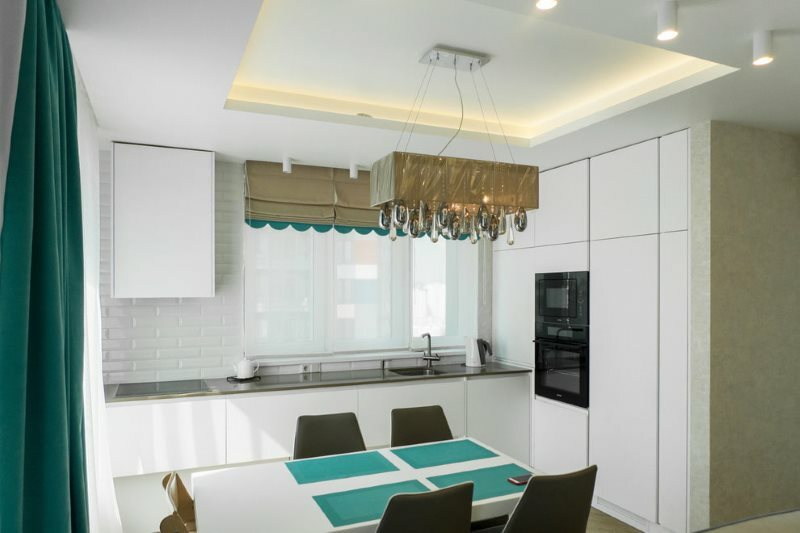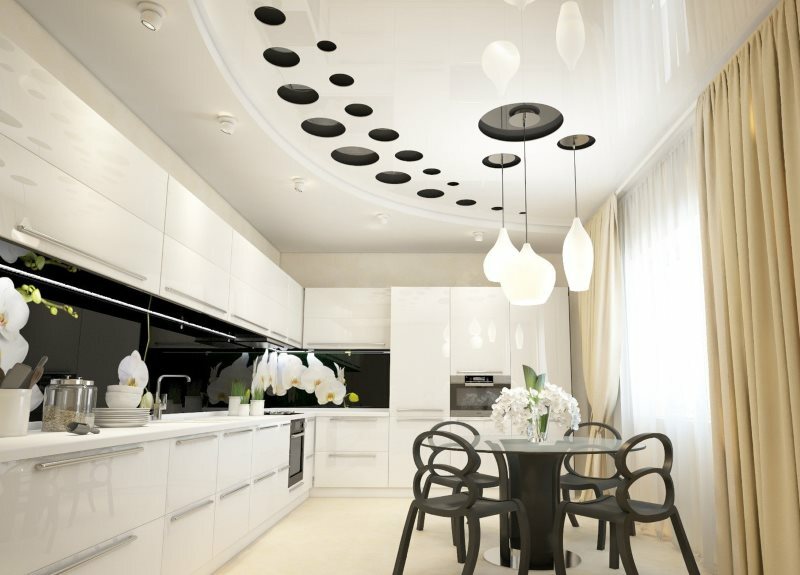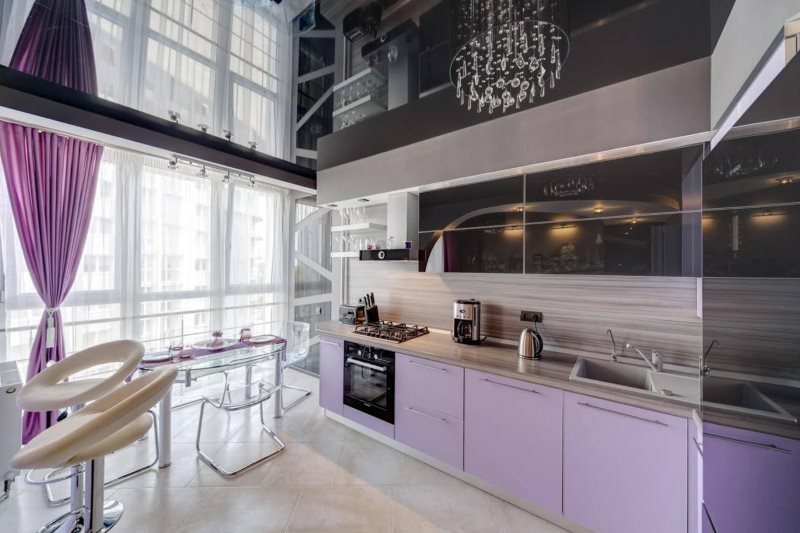For a long time, the creation of multi-level structures for decorating and correcting the imperfections of the ceiling space was possible only with the use of drywall. The many disadvantages of this method, associated with the complexity of installation and decoration, as well as the abundance of construction waste, did not allow bunk ceilings to take their due place in the design of premises. The modern solution to these problems is multilevel stretch ceilings.

Stretch ceiling in the kitchen is a convenient and practical solution that can compete well with any other finishing material
The general principle of installing two-level tension structures is as follows:
- Project creation. At this stage, the design is agreed with the customer, the premises are examined and the required amount of materials and the amount of work are calculated.
- Creation of markup. One of the most important stages in the installation of a stretch ceiling. On the walls and ceiling, predetermined places are marked for future fastening of the base elements. The main condition is the location of the marks at the same level.
- Installing a profile. A frame is erected on the ceiling, the elements of which are mounted taking into account the existing marks. For the profile, aluminum or polyvinyl chloride is usually used.
- Installation of the canvas. Different installation technologies are used depending on the material. They differ only in the way of fastening the web to the profile.
- Finishing. All cracks and technological holes are covered with decorative elements.
- Lighting installation. In the cavity formed under the stretched canvas, lamps are installed and connected.

Installation of a tensioning web of any configuration is carried out within one working day. The development of the project and preparatory work takes more time if any combined structures are used
Design of kitchen multi-level stretch ceilings
Content
- Design of kitchen multi-level stretch ceilings
- Pros and cons of tension structures
- Varieties of stretch ceilings
- Design from elite materials
- Popular colors
- Lighting design
- Video: design of kitchen ceilings
- Photo: stretch ceilings in the interior of the kitchen
The variety of materials, colors and textures, as well as the absence of fundamental restrictions on the structure of the frame, allows you to create a unique interior. For example, a fairly common phenomenon is the use of film with photo printing.

Stretch ceiling with photo printing will add bright colors to the kitchen interior
For the arrangement of the kitchen, the ceiling space is usually divided into 2 zones: a working and a dining room. Also, at the junctions of the levels, you can place LED strips, which will provide soft and uniform illumination of the room.

A ceiling with tiers of different colors is an effective way of zoning kitchen space.

One of the tiers of this ceiling exactly repeats the outlines of the kitchen island, ideally zoning the space.
At the junctions of the ceiling levels, all corners are rounded. This is done not only to maintain a certain style, but also to avoid crushing and damage to the material of the canvas.

Wave-shaped design smoothes the geometry of the room and gives it a more elegant look

Clear forms and strict proportions attract attention and create the necessary accents in the interior

A semicircle located on the ceiling simultaneously unites and zones the space of the room

The corner design introduces a slight irregularity into the interior and makes the space more complex and unusual
Pros and cons of tension structures
The advantages of a two-tier system are usually the following:
- Installation speed. Provided that the installation is carried out by experienced professionals, a two-level stretch ceiling can be assembled in 1 day.
- Ease of finishing. After the work is completely completed, it remains only to hide the remaining cracks with decorative overlays.
- Room zoning. By correctly implementing multi-level ceilings in the kitchen, you can achieve a visual division of space into separate areas.
- Reliability. In the absence of accidents such as flooding or mechanical damage, such a system can last more than 10 years.
- Versatility. Due to their qualities, stretch ceilings can be installed in almost all types of premises. For the bathroom and other rooms with high humidity, special moisture-resistant materials are used.

The stretch ceiling, thanks to its unlimited possibilities of various combinations, allows you to turn the ceiling plane into a real design masterpiece
There are few disadvantages of the design in question, and for the most part they relate to the film type:
- Instability to temperature changes. In irregularly heated rooms, the film will expand and contract, which can lead to cracks and tears.
- Vulnerability to flooding. When water gets into the space between the ceiling tiles and the stretched fabric, it will significantly deform and sag. Only a complete replacement of the entire canvas will help to correct the situation.
When cleaning, it is strictly forbidden to use chemically active detergents to avoid damage to the material.

The stretch fabric can be smooth and even, or display a decorative structure or art pattern.
Varieties of stretch ceilings
Stretch ceilings can be divided according to the material of the canvas into groups: film and fabric.
The first type includes:
- Glossy ones have a perfectly smooth surface that reflects light well. Installing a two-level stretch ceiling in the kitchen will visually expand the room and evenly fill it with light.

Smooth, shiny surface perfectly reflects light and creates the illusion of a large space
- Matte. A stricter version that fully fits into modern minimalist concepts of interior design.

The matte surface looks like a regular, but perfectly painted ceiling
Stretch ceilings made using fabric are difficult to differentiate into categories, it all depends only on the type of canvas. The system, made of good fabric, looks like a ceiling perfectly aligned with plaster from a distance.

Fabric stretch ceiling with a pattern matched to the tone of the kitchen unit facades
Design from elite materials
In addition to PVC film and standard fabrics, more expensive materials can be used to create a luxurious interior. For example, some companies produce satin fabric for stretch ceilings. This fabric is made by weaving silk and cotton fibers and has a soft texture that does not reflect light.

An unobtrusive satin canvas will create a light and relaxed atmosphere in the room.

It is important to remember that ceiling decoration significantly affects the proportions of the room.
Popular colors
The most common color schemes are all shades of black and white, as well as soft, not too saturated colors, however, there are no restrictions on the color palette for film ceilings. As for the fabric, the choice is much narrower, manufacturers provide about 20 fabric colors.

The ceiling in a light pastel tone visually increases the space of the room

The white color of the ceiling adds light and freshness to the room, helps to hide some of the design flaws of the room

Black canvas will create a mysterious and mystical atmosphere

Light green color will give a good mood

The color of the sky or aqua will add spatial depth to the room and form a strict interior.
Lighting design
Due to the fact that an empty space is formed between the stretch ceiling and the floor slab, the lamps can be built into the canvas. In addition, it is possible to install LED strips at the point where the levels meet.

The placement and methods of fixing the luminaires are thought out before installing the stretch ceiling

With built-in lighting, you can adjust the space without affecting the architectural possibilities of the room

By creating light illusions and shadow drops, it is possible to solve the most complex design problems
Combined lighting is most often used in multi-level systems. Luminaires are built into the protruding areas, and a chandelier is hung at a higher level. This model correlates with the zoning of the room space and allows you to concentrate light only in the place where it is needed.

Lighting devices of any type and shape do an excellent job with the role of zoning elements. For example, a dining area can be highlighted with a chandelier, and a workspace with spotlights.
Taking into account all the advantages and disadvantages of two-level stretch ceilings, it is safe to say that such a system is one of the best design solutions. The variety of available shapes and colors, as well as high reliability, allow installing tension structures in rooms with any interior.

